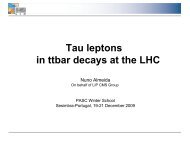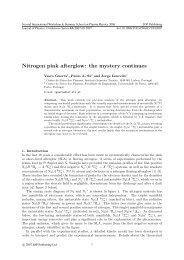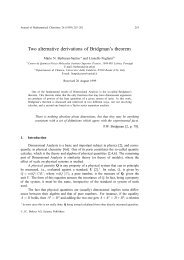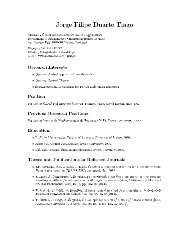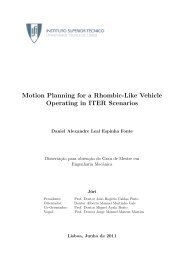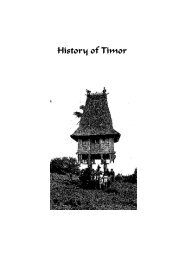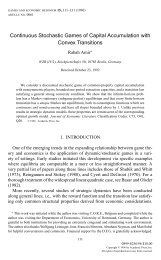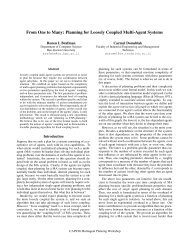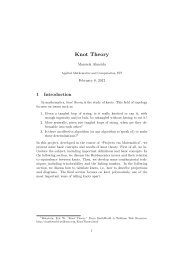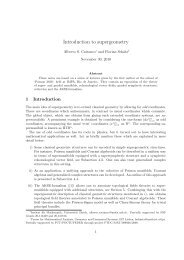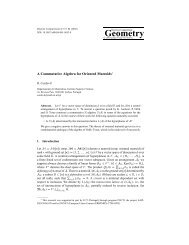Dual Fluorescence Sensor for Trace Oxygen and Temperature with ...
Dual Fluorescence Sensor for Trace Oxygen and Temperature with ...
Dual Fluorescence Sensor for Trace Oxygen and Temperature with ...
Create successful ePaper yourself
Turn your PDF publications into a flip-book with our unique Google optimized e-Paper software.
Anal. Chem. 2008, 80, 6449–6457<br />
<strong>Dual</strong> <strong>Fluorescence</strong> <strong>Sensor</strong> <strong>for</strong> <strong>Trace</strong> <strong>Oxygen</strong> <strong>and</strong><br />
<strong>Temperature</strong> <strong>with</strong> Unmatched Range <strong>and</strong><br />
Sensitivity<br />
Carlos Baleizão,* ,†,‡ Stefan Nagl, ‡ Michael Schäferling, ‡ Mário N. Berberan-Santos, † <strong>and</strong><br />
Otto S. Wolfbeis ‡<br />
CQFM-Centro de Química-Física Molecular <strong>and</strong> IN-Institute of Nanoscience <strong>and</strong> Nanotechnology, Instituto Superior<br />
Técnico, Universidade Técnica de Lisboa, P-1049-001 Lisboa, Portugal, <strong>and</strong> Institute of Analytical Chemistry, Chemo<strong>and</strong><br />
Biosensors, University of Regensburg, 93040 Regensburg, Germany<br />
An optical dual sensor <strong>for</strong> oxygen <strong>and</strong> temperature is<br />
presented that is highly oxygen sensitive <strong>and</strong> covers a<br />
broad temperature range. <strong>Dual</strong> sensing is based on<br />
luminescence lifetime measurements. The novel sensor<br />
contains two luminescent compounds incorporated into<br />
polymer films. The temperature-sensitive dye (ruthenium<br />
tris-1,10-phenanthroline) has a highly temperature-dependent<br />
luminescence <strong>and</strong> is incorporated in poly(acrylonitrile)<br />
to avoid cross-sensitivity to oxygen. Fullerene C 70<br />
was used as the oxygen-sensitive probe owing to its strong<br />
thermally activated delayed fluorescence at elevated temperatures<br />
that is extremely oxygen sensitive. The crosssensitivity<br />
of C 70 to temperature is accounted <strong>for</strong> by means<br />
of the temperature sensor. C 70 is incorporated into a<br />
highly oxygen-permeable polymer, either ethyl cellulose<br />
or organosilica. The two luminescent probes have different<br />
emission spectra <strong>and</strong> decay times, <strong>and</strong> their emissions<br />
can be discriminated using both parameters. Spatially<br />
resolved sensing is achieved by means of fluorescence<br />
lifetime imaging. The response times of the sensor to<br />
oxygen are short. The dual sensor exhibits a temperature<br />
operation range between at least 0 <strong>and</strong> 120 °C, <strong>and</strong><br />
detection limits <strong>for</strong> oxygen in the ppbv range, operating<br />
<strong>for</strong> oxygen concentrations up to at least 50 ppmv. These<br />
ranges outper<strong>for</strong>m all dual oxygen <strong>and</strong> temperature sensors<br />
reported so far. The dual sensor presented in this<br />
study is especially appropriate <strong>for</strong> measurements under<br />
extreme conditions such as high temperatures <strong>and</strong> ultralow<br />
oxygen levels. This dual sensor is a key step<br />
<strong>for</strong>ward in a number of scientifically or commercially<br />
important applications including food packaging, <strong>for</strong><br />
monitoring of hyperthermophilic microorganisms, in space<br />
technology, <strong>and</strong> safety <strong>and</strong> security applications in terms<br />
of detection of oxygen leaks.<br />
<strong>Oxygen</strong>, being essential <strong>for</strong> life, is an immensely important<br />
chemical species. Determination of oxygen levels is required in<br />
numerous areas, including medicine, biotechnology, aerospace<br />
* To whom correspondence should be addressed. Tel.: +351 218-419-206. Fax:<br />
+351 218-464-455. E-mail: carlos.baleizao@ist.utl.pt.<br />
† Universidade Técnica de Lisboa.<br />
‡ University of Regensburg.<br />
research, food packaging, <strong>and</strong> the chemical industry. After the<br />
invention of the first optical, fluorescence-based sensor <strong>for</strong> oxygen<br />
40 years ago, 1 it appeared hardly likely that optical sensors would<br />
rival the very successful <strong>and</strong> sensitive electrochemical oxygen<br />
measurement technique based on Clark electrodes. In the last<br />
decades, the potential offered by specific advantages of optical<br />
methods has been realized to a large extent. Among the many<br />
optical methods employed <strong>for</strong> sensing, fluorescence has attracted<br />
special attention because it is highly sensitive, versatile, noninvasive,<br />
<strong>and</strong> of low toxicity. 2,3 <strong>Fluorescence</strong>-based sensors, in not<br />
requiring a physical contact <strong>with</strong> the medium during measurement,<br />
are advantageous compared to contact sensors in applications<br />
where electromagnetic noise is strong or it is physically<br />
difficult to connect a wire. Further advantages of sensors based<br />
on molecular fluorescence are the very fast response, the reversibility,<br />
<strong>and</strong> the spatial resolution that can go from the macroscale<br />
(fluorescent paints) down to the nanoscale (fluorescence microscopy).<br />
These properties also overcome the limitations of electrochemical<br />
sensors, which are difficult to miniaturize, invasive, <strong>and</strong><br />
limited to discrete points. 4<br />
All known fluorescence-based oxygen sensors, <strong>and</strong> in fact<br />
almost any sensor, no matter what type, suffer from interference<br />
by temperature. This interference can be corrected <strong>for</strong> using a<br />
second sensor to measure temperature. True multiple sensing<br />
methods are based on the use of a single sensor that yields a<br />
large amount of optical data, which provides in<strong>for</strong>mation on more<br />
than one physical or chemical parameter. 5 Up to date, several<br />
kinds of dual sensors have been described, e.g., <strong>for</strong> CO 2 /O 2 , 6–8<br />
O 2 /T, 9–15 <strong>and</strong> pH/O 2 . 16–18<br />
(1) Bergman, I. Nature 1968, 218, 396.<br />
(2) Optical <strong>Sensor</strong>s <strong>for</strong> Industrial, Environmental <strong>and</strong> Clinical Applications;<br />
Narayanaswamy, R., Wolfbeis O. S., Eds.; Springer: Berlin, 2004.<br />
(3) Wolfbeis, O. S. Anal. Chem. 2008, 80, 4269-4283;. <strong>and</strong> previous biannual<br />
reviews.<br />
(4) Optical Chemical <strong>Sensor</strong>s; Baldini F., Chester, A. N., Homola, J., Martellucci,<br />
S., Eds; Springer: Dordrecht, 2006.<br />
(5) Nagl, S.; Wolfbeis, O. S. Analyst 2007, 132, 507–511.<br />
(6) Wolfbeis, O. S.; Weis, L. J.; Leiner, M. J. P.; Ziegler, W. E. Anal. Chem.<br />
1988, 60, 2028–2030.<br />
(7) Borisov, S. M.; Krause, C.; Arain, S.; Wolfbeis, O. S. Adv. Mater. 2006,<br />
18, 1511–1516.<br />
(8) Schroeder, C. R.; Neurauter, G.; Klimant, I. Microchim. Acta 2007, 158,<br />
205–218.<br />
(9) Coyle, L. M.; Gouterman, M. Sens. Actuators, B 1999, 61, 92–99.<br />
10.1021/ac801034p CCC: $40.75 © 2008 American Chemical Society Analytical Chemistry, Vol. 80, No. 16, August 15, 2008 6449<br />
Published on Web 07/24/2008
Pressure-sensitive paints (PSPs) <strong>and</strong> temperature-sensitive<br />
paints have been the subject of intense research that contributed<br />
to vast progress in the past years. 19,20 PSPs are essentially oxygen<br />
sensors that take advantage of the fact that the fraction of oxygen<br />
in air is constant, allowing the calculation of total pressure from<br />
the oxygen partial pressure. 21 With these materials, it is possible<br />
to record the entire surface distribution of a large object (e.g., an<br />
aircraft in a wind tunnel), rather than just discrete points as <strong>with</strong><br />
other sensors. 22 Sometimes, only trace concentrations of oxygen<br />
are employed in wind tunnels because sensor response is most<br />
sensitive under these conditions as a result of the Stern-Volmer<br />
equation.<br />
Most of the food found in supermarkets is processed <strong>and</strong><br />
storedintheabsenceofoxygen(modifiedatmospherepackaging). 23,24<br />
At the same time, food requires a specific range of temperatures<br />
during storage <strong>and</strong> transport to maximize its shelf life. <strong>Dual</strong><br />
oxygen <strong>and</strong> temperature fluorescence sensors also have found<br />
application in this area, especially because it is a remote <strong>and</strong><br />
noninvasive method, meaning that oxygen <strong>and</strong> temperature can<br />
be monitored <strong>with</strong>out any contact to the sealing. 25,26<br />
<strong>Oxygen</strong> <strong>and</strong> temperature sensing also play a crucial role in<br />
the area of microbiology, namely, in growth monitoring. Optical<br />
sensors are being increasingly used, <strong>and</strong> a number of fluorescent<br />
dual sensors have been described recently. 7,18 It is challenging<br />
in this field to monitor organisms that grow under unusual<br />
conditions, e.g., hyperthermophilic organisms that require high<br />
temperatures, 27 <strong>and</strong> atmospheres of residual oxygen to anaerobic<br />
conditions. 27 These organisms are also c<strong>and</strong>idates <strong>for</strong> hydrogen<br />
production in a future hydrogen economy. 28 Another area of<br />
interest is chemical process <strong>and</strong> reaction monitoring. Many<br />
chemical reactions need to be carried out in the complete absence<br />
of oxygen <strong>and</strong> at high temperatures. Optical sensors enable us to<br />
(10) Hradil, J.; Davis, C.; Mongey, K.; McDonagh, C.; MacCraith, B. D. Meas.<br />
Sci. Technol. 2002, 13, 1552–1557.<br />
(11) Zelelow, B.; Khalil, G. E.; Phelan, G.; Carlson, B.; Gouterman, M.; Callis,<br />
J. B.; Dalton, L. R. Sens. Actuators, B 2003, 96, 304–314.<br />
(12) Köse, M. E.; Carroll, B. F.; Schanze, K. S. Langmuir 2005, 21, 9121–9129.<br />
(13) Borisov, S. M.; Wolfbeis, O. S. Anal. Chem. 2006, 78, 5094–5101.<br />
(14) Borisov, S. M.; Vasylevska, A. S.; Krause, C.; Wolfbeis, O. S. Adv. Funct.<br />
Mater. 2006, 16, 1536–1542.<br />
(15) Stich, M. I. J.; Nagl, S.; Wolfbeis, O. S.; Henne, U.; Schaeferling, M. Adv.<br />
Funct. Mater. 2008, 18, 1399–1406.<br />
(16) Vasylevska, G. S.; Borisov, S. M.; Krause, C.; Wolfbeis, O. S. Chem. Mater.<br />
2006, 18, 4609–4616.<br />
(17) Schröder, C. R.; Polerecky, L.; Klimant, I. Anal. Chem. 2007, 79, 60–70.<br />
(18) Kocincová, A. S.; Nagl, S.; Arain, S.; Krause, C.; Borisov, S. M.; Arnold, M.;<br />
Wolfbeis, O. S. Biotechnol. Bioeng. 2008, 100, 430–438.<br />
(19) Pressure <strong>and</strong> <strong>Temperature</strong> Sensitive Paints; Liu, T., Sullivan, J. P., Eds;<br />
Springer: New York, 2005.<br />
(20) Frontiers in Chemical <strong>Sensor</strong>s; Orellana, G., Moreno-Bondi, M. C., Eds;<br />
Springer: Berlin, 2005.<br />
(21) Mitsuo, K.; Asai, K.; Takahashi, A.; Mizushima, H. Meas. Sci. Technol. 2006,<br />
17, 1282–1291.<br />
(22) Kontis, K. Aeronautical J. 2007, 111, 495–508.<br />
(23) Mills, A. Chem. Soc. Rev. 2005, 34, 1003–1011.<br />
(24) Valverde, J. M.; Guillen, F.; Martinez-Romero, D.; Castillo, S.; Serrano, M.;<br />
Valero, D. J. Agric. Food Chem. 2005, 53, 7458–7464.<br />
(25) Fitzgerald, M.; Papkovsky, D. B.; Smiddy, M.; Kerry, J. P.; O’Sullivan, C. K.;<br />
Buckley, D. J.; Guilbault, G. G. J. Food Sci. 2001, 66, 105–110.<br />
(26) Papkovsky, D. B.; Smiddy, M. A.; Papkovskaia, N. Y.; Kerry, J. P. J. Food<br />
Sci 2002, 67, 3164–3169.<br />
(27) Extremophiles; Rainey, F. A., Oren, A., Eds; Academic Press: Amsterdam,<br />
2006.<br />
(28) de Vrije, T.; Mars, A. E.; Budde, M. A. W.; Lai, M. H.; Dijkema, C.; de<br />
Waard, P.; Claassen, P. A. M. Appl. Microbiol. Biotechnol. 2007, 74, 1358–<br />
1367.<br />
observe the reaction parameters <strong>with</strong>out disturbance, but at<br />
present, they are limited to moderate temperatures <strong>and</strong> not<br />
applicable at trace oxygen levels. 9–15<br />
A variety of devices <strong>and</strong> sensors based on molecular optical<br />
properties has been developed to measure oxygen partial<br />
pressure. 29,30 For trace oxygen sensing, the choice of sensors is<br />
between palladium <strong>and</strong> platinum porphyrins or ruthenium complexes<br />
that most often are immobilized in oxygen-permeable<br />
materials, <strong>with</strong> sensitivities in the ppmv range. 31,32 Another<br />
approach toward trace oxygen sensing is based on the thermally<br />
activated delayed fluorescence (TADF) effect displayed by C 70 ,<br />
leading to an extremely efficient quenching of the intensity <strong>and</strong><br />
lifetime of TADF <strong>and</strong>, hence, resulting in sensitivities in the ppbv<br />
range. 33<br />
<strong>Temperature</strong> sensing based on luminescence lifetime changes,<br />
using fiber optics in combination <strong>with</strong> phosphors, is a wellestablished<br />
method. 34 More recently, several studies have been<br />
devoted to fluorescence-based molecular thermometry, 35,36 by<br />
exploiting the temperature dependence of either intensity, quantum<br />
yield, or lifetime of the luminescence of hydrocarbons, the<br />
exciplex <strong>for</strong>mation in anilines <strong>and</strong> perylenes, of fluorescence<br />
quenching, 37 <strong>and</strong> of the TADF of fullerenes. 38–40<br />
Most dual sensors of O 2 /T reported so far 9–15 have in common<br />
a single excitation wavelength in the visible region, luminescence<br />
decay time as the analytical signal, a single matrix to disperse<br />
both temperature <strong>and</strong> oxygen probes, <strong>and</strong> working ranges from<br />
0to70°C <strong>and</strong> over O 2 concentrations in the 0-100% range.<br />
Detection limits in the best cases, are at ppmv values. We describe<br />
here a dual sensor <strong>for</strong> simultaneous sensing of oxygen concentrations<br />
below 50 ppmv <strong>and</strong> temperatures up to 120 °C, based on<br />
luminescence lifetime measurements <strong>and</strong> that we assume to be<br />
useful in the areas outlined above.<br />
EXPERIMENTAL SECTION<br />
Materials. C 70 (>99.9%), ruthenium(II)-tris-1,10-phenanthroline<br />
chloride hydrate, titanium dioxide, hexane, toluene, <strong>and</strong> ethyl<br />
cellulose 49 (EC) were purchased from Sigma-Aldrich (www.sigmaaldrich.com).<br />
Silicone RS 692-542 was obtained from RS<br />
Components (www.rs-components.com). Dimethyl<strong>for</strong>mamide<br />
(Acros, www.acros.com) was used as received. Polyacrylonitrile<br />
(PAN, powder, M w ∼170 000) was purchased from Polysciences<br />
(www.polysciences.com). Ruthenium(II)-tris-1,10-phenanthroline<br />
(29) Ramamoorthy, R.; Dutta, P. K.; Akbar, S. A. J. Mater. Sci. 2003, 38, 4271–<br />
4282.<br />
(30) DeGraff B. A.; Demas, J. N. In Reviews in <strong>Fluorescence</strong> 2005; Geddes C. D.,<br />
Lakowicz, J. R., Eds; Springer Science: New York, 2005; pp 125-150.<br />
(31) Apostolidis, A.; Klimant, I.; Andrzejewski, D.; Wolfbeis, O. S. J. Comb. Chem.<br />
2004, 6, 325–331.<br />
(32) Han, B. H.; Manners, I.; Winnik, M. A. Chem. Mater. 2005, 17, 3160–<br />
3171.<br />
(33) Nagl, S.; Baleizão, C.; Borisov, S. M.; Schäferling, M.; Berberan-Santos,<br />
M. N.; Wolfbeis, O. S. Angew. Chem., Int. Ed. 2007, 46, 2117–2119.<br />
(34) Fiber Optic <strong>Fluorescence</strong> Thermometry; Grattan, K. T., Zhang, Z. Y., Eds;<br />
Chapman <strong>and</strong> Hall: London, 1995.<br />
(35) Demas, J. N.; DeGraff, B. A. Coor. Chem Rev. 2001, 211, 317–351.<br />
(36) Uchiyama, S.; de Silva, A. P.; Iwau, K. J. Chem. Educ. 2006, 83, 720–727.<br />
(37) Amao, Y. Microchim. Acta 2003, 143, 1–12.<br />
(38) Berberan-Santos, M. N.; Garcia, J. M. M. J. Am. Chem. Soc. 1996, 118,<br />
9391–9394.<br />
(39) Baleizão, C.; Berberan-Santos, M. N. J. Fluoresc. 2006, 16, 215–219.<br />
(40) Baleizão, C.; Nagl, S.; Borisov, S. M.; Schäferling, M.; Wolfbeis, O. S.;<br />
Berberan-Santos, M. N. Chem. Eur. J. 2007, 13, 3643–3651.<br />
6450 Analytical Chemistry, Vol. 80, No. 16, August 15, 2008
3-trimethylsilyl-1-propanesulfonate [Ru(phen) 3 ] 41 <strong>and</strong> organosilica<br />
(OS) 42 were prepared according to the literature.<br />
Methods. Preparation of the Two-Layer <strong>Dual</strong> <strong>Sensor</strong>s. The<br />
sensor layers were prepared in two steps. First, a layer of<br />
Ru(phen) 3 /PAN in dimethyl<strong>for</strong>mamide (DMF) was spread onto<br />
a polyester foil <strong>and</strong> after evaporation of the solvent, a second layer<br />
of C 70 /OSorC 70 /EC, both in toluene, was spread over the first<br />
layer. The Ru(phen) 3 /PAN mixture was prepared by mixing<br />
Ru(phen) 3 (2 mg) <strong>and</strong> PAN (100 mg) in DMF (1.9 g) <strong>and</strong> stirring<br />
<strong>for</strong> 20 min at 50 °C. The mixture was spread as 120-µm-thick films<br />
(using a coater from RK Print-Coat Instruments Ltd.; www.rkprint.com)<br />
onto a 125 µm poly(ethylene terephthalate) (Mylar)<br />
foil from Goodfellow (www.goodfellow.com). The solvent was<br />
allowed to evaporate to yield a layer of ∼6 µm thickness. The<br />
C 70 /OS layer was prepared by dissolving C 70 (1 mg) <strong>and</strong> OS (100<br />
mg) in toluene (0.9 g) <strong>and</strong> stirring at room temperature <strong>for</strong> 15<br />
min. C 70 /EC was obtained by dissolving C 70 (1 mg) <strong>and</strong> EC (100<br />
mg) in toluene (1.9 g), <strong>and</strong> the solution was ultrasonicated <strong>and</strong><br />
heated at 40 °C <strong>for</strong> 15 min. Both solutions were spread as 120-<br />
µm-thick films over the Ru(phen) 3 /PAN layer to yield dry layers<br />
of ∼12 (C 70 /OS) <strong>and</strong> 6 µm (C 70 /EC) thicknesses. The reflective<br />
layer was prepared by dissolving 1gofone-component silicone<br />
RS692-542 <strong>and</strong> 0.3 g of TiO 2 in 0.7 g of hexane, <strong>and</strong> after 30 min<br />
of stirring, it was knife-coated as 120-µm-thick films onto the 125<br />
µm polyester foil <strong>and</strong> left <strong>for</strong> curing overnight.<br />
Spectral Characterization. Absorption <strong>and</strong> emission spectra<br />
were recorded on a Lambda 14 P UV-vis spectrophotometer<br />
(www.perkinelmer.com) <strong>and</strong> Aminco AB 2 luminescence spectrometer<br />
(www.thermo.com), respectively.<br />
<strong>Sensor</strong> Calibration. All measurements were carried out in a<br />
self-developed custom flow chamber, where a piece of the sensor<br />
strip was placed along <strong>with</strong> the scatter layer. The chamber was<br />
connected to a RC6 thermostat from Lauda (www.lauda.com)<br />
which ran on silicon oil M 10 from Roth (www.roth.de). The gas<br />
flow in the cell was adjusted by two PR 4000 pressure controllers<br />
(MKS Instruments, www.mksinst.com). Calibration gases (nitrogen<br />
<strong>and</strong> 50 ppm O 2 in nitrogen) were obtained from Linde<br />
(www.linde-gase.de).<br />
Imaging of C 70 <strong>and</strong> Ru(phen) 3 . The optical setup was identical<br />
to that in earlier studies. 33,40 Excitation light was filtered through<br />
an FITCA filter (Schott, www.schott.de). Emission was recorded<br />
through a Chroma 680 filter <strong>for</strong> the fullerene <strong>and</strong> a Chroma 580<br />
filter <strong>for</strong> the Ru complex, both filters having a full width at halfmaximum<br />
of ∼60 nm (AHF Analysentechnik, www.ahf.de). For<br />
calculation of luminescence lifetimes, the rapid lifetime determination<br />
(RLD) method was used. 43 Following a square-shaped light<br />
pulse, luminescence was detected quantitatively in two different<br />
gates. The first gate (G 1 ) was only opened after a delay period<br />
after switching off the LEDs. This suppresses short-lived background<br />
fluorescence almost quantitatively. Potential interferences<br />
caused by backscattered excitation light are also eliminated in<br />
this manner. The second gate (G 2 ) is opened immediately after<br />
the closure of G 1 . In the case of Ru(phen) 3 , the gates started 250<br />
<strong>and</strong> 1250 ns after switching off the LEDs, they were 1 µs long<br />
each, <strong>and</strong> the LED was turned on <strong>for</strong> 4 µs <strong>with</strong> a repetition rate<br />
(41) Liebsch, G.; Klimant, I.; Wolfbeis, O. S. Adv. Mater. 1999, 11, 1296–1299.<br />
(42) Brusatin, G.; Innocenzi, P. J. Sol-Gel Sci. Technol. 2001, 22, 189–204.<br />
(43) Liebsch, G.; Klimant, I.; Frank, B.; Holst, G.; Wolfbeis, O. S. Appl. Spectrosc.<br />
2000, 54, 548–559.<br />
Figure 1. Cross section of the sensor layers <strong>for</strong> simultaneous optical<br />
sensing <strong>and</strong> imaging of oxygen <strong>and</strong> temperature. The luminescence<br />
of the compounds is excited from above, <strong>and</strong> emission is also<br />
collected there. The TiO 2 reflective layer acts as a scattering area to<br />
increase the intensity of the luminescence collected above.<br />
of 100 kHz. For C 70 , the gates started 100 <strong>and</strong> 5100 µs after<br />
switching off the LEDs, they were 5 ms long each, <strong>and</strong> the LED<br />
was turned on <strong>for</strong> 30 ms <strong>with</strong> a repetition rate of 10 Hz. The ratio<br />
G 1 /G 2 is virtually independent of the overall signal intensity.<br />
Assuming a constant aperture time <strong>for</strong> each gate, the average<br />
decay time τ of each pixel can be calculated as τ ) ∆t/ln(G 1 /<br />
G 2 )where ∆t is the integration time <strong>and</strong> G 1 <strong>and</strong> G 2 are the areas<br />
of each gate.<br />
RESULTS AND DISCUSSION<br />
Composition, Calibration, <strong>and</strong> Properties of the <strong>Dual</strong><br />
<strong>Sensor</strong>s. The material contains two sensor layers, each <strong>with</strong> the<br />
luminescent probe dispersed in a polymer matrix, thus allowing<br />
simultaneous determination of oxygen partial pressure <strong>and</strong> temperature.<br />
Figure 1 schematically shows the cross section of the<br />
final composite sensor material.<br />
The accurate sensing of oxygen <strong>and</strong> temperature is often<br />
affected by the mutual cross-sensitivities of the indicators, which<br />
have to be minimized. The cross-sensitivities can result from<br />
several effects: (i) overlap of the luminescence signals from both<br />
probes; (ii) temperature dependence of the lifetime <strong>and</strong> quenching<br />
kinetics of the oxygen probe; or (iii) quenching of the temperature<br />
probe by oxygen. To avoid the cross-sensitivities <strong>and</strong> to achieve<br />
optimal sensitivities, both probes <strong>and</strong> polymers must be carefully<br />
chosen.<br />
The luminescences of ruthenium(II) polypyridyl complexes<br />
exhibit a strong temperature dependence. 35 In particular, ruthenium(II)<br />
tris(phenanthroline) (Ru(phen) 3 ) is a common optical<br />
temperature probe that displays efficient temperature quenching<br />
<strong>and</strong> there<strong>for</strong>e high sensitivity. 41 Ru(phen) 3 complexes can be<br />
easily incorporated into solid matrixes, such as sol-gels or<br />
polymers. 4,44,45 The photostability of these complexes is rather<br />
high in the absence of oxygen, <strong>and</strong> they can be excited in the<br />
visible region. The brightness (defined as the product of the molar<br />
absorption coefficient ɛ <strong>and</strong> the quantum yield Φ) of Ru(phen) 3<br />
in PAN at room temperature is ∼2000 <strong>and</strong> decreases to 200 at<br />
100 °C. 40,46 The luminescence of Ru(II) polypyridyl complexes is<br />
quenched by oxygen. In order to avoid this interference when<br />
sensing temperature, the Ru(phen) 3 complex was immobilized in<br />
PAN. The extremely low gas permeability of PAN (P ) 1.5 × 10 -17<br />
cm 2 Pa s -1 ) 47 in essence eliminates quenching by oxygen.<br />
(44) Wolfbeis, O. S. J. Mater. Chem. 2006, 15, 2657–2669.<br />
(45) <strong>Fluorescence</strong> of Supermolecules, Polymers, <strong>and</strong> Nanosystems; Berberan-Santos,<br />
M. N., Ed.; Springer: Berlin, 2008.<br />
(46) Al<strong>for</strong>d, P. C.; Cook, M. J.; Lewis, A. P.; McAuliffe, S. G.; Skarda, V.;<br />
Thomson, A. J. J. Chem. Soc., Perkin Trans. 2 1985, 5, 705–709.<br />
(47) Br<strong>and</strong>rup, J., Immergut, E. H. Grulke, E. A. Polymer H<strong>and</strong>book; Wiley: New<br />
York, 1999.<br />
Analytical Chemistry, Vol. 80, No. 16, August 15, 2008<br />
6451
Fullerene C 70 displays the TADF effect. In fact, there are two<br />
distinct unimolecular mechanisms <strong>for</strong> its fluorescence: prompt<br />
fluorescence (PF) <strong>and</strong> TADF. 48,49 In the PF mechanism, emission<br />
occurs after S n r S 0 absorption <strong>and</strong> excited-state relaxation to S 1 .<br />
The TADF mechanism takes place via the triplet manifold: after<br />
excitation to the S 1 state, intersystem crossing (ISC) to the triplet<br />
manifold (T 1 or a higher triplet) occurs, followed by a second ISC<br />
from T 1 back to S 1 , <strong>and</strong> by prompt fluorescence. The cycle S 1 f<br />
T 1 f S 1 may be repeated a number of times be<strong>for</strong>e fluorescence<br />
finally takes place. 50 TADF is significant only when several<br />
conditions are met: a small energy gap between S 1 <strong>and</strong> T 1 (∆E ST ),<br />
a long T 1 lifetime, <strong>and</strong> temperature high enough <strong>for</strong> this process<br />
to take place. 38 For most fluorophores, TADF is usually much<br />
weaker than PF. Although known <strong>for</strong> many years, TADF continues<br />
to be a rare phenomenon, <strong>with</strong> a few observations in some<br />
xanthene dyes, 49,51,52 aromatic ketones 53,54 <strong>and</strong> thiones, 55,56 metal<br />
porphyrins, 57 imidazole derivatives, 58 <strong>and</strong> aromatic hydrocarbons.<br />
59,60<br />
The photophysical properties of fullerene C 70 are remarkable<br />
in that the Φ T is close to 1, 61 the ∆E ST gap 62 is small, <strong>and</strong> the<br />
intrinsic phosphorescence lifetime is rather long. 63 Such properties<br />
are required <strong>for</strong> the exceptionally strong TADF 35 found to occur.<br />
C 64 60 <strong>and</strong> some C 60 derivatives, 65,66 as well as one C 70 derivative, 67<br />
also exhibit TADF, but <strong>with</strong> much less efficiency than C 70 .<br />
The outst<strong>and</strong>ing TADF effect displayed by C 70 <strong>with</strong> a maximal<br />
increase in the quantum yield by a factor of ∼100, <strong>and</strong> the fact<br />
that TADF lifetimes fall in the millisecond range, 40 are most useful<br />
features <strong>for</strong> the development of a trace oxygen sensor. Its<br />
sensitivity to O 2 increases <strong>with</strong> T because the molecule resides<br />
longer in the triplet state (<strong>and</strong> more efficiently interacts <strong>with</strong><br />
(triplet) oxygen) at higher temperatures. On the other h<strong>and</strong> only<br />
the unique TADF effect, based on a cycling of the molecule<br />
(48) Valeur, B. Molecular <strong>Fluorescence</strong>: Principles <strong>and</strong> Applications; Wiley:<br />
Weinheim, 2002.<br />
(49) Parker, C. A. Photoluminescence of Solutions; Elsevier: Amsterdam, 1968.<br />
(50) Baleizão, C.; Berberan-Santos, M. N. J. Chem. Phys. 2007, 126, 204510.<br />
(51) Lam, S. K.; Lo, D. Chem. Phys. Lett. 1997, 281, 35–43.<br />
(52) Duchowicz, R.; Ferrer, M. L.; Acuña,A.U.Photochem. Photobiol. 1998,<br />
68, 494–501.<br />
(53) Wolf, M. W.; Legg, K. D.; Brown, R. E.; Singer, L. A.; Parks, J. H. J. Am.<br />
Chem. Soc. 1975, 97, 4490–4497.<br />
(54) Turek, A. M.; Krishnammorthy, G.; Phipps, K.; Saltiel, J. J. Phys. Chem. A<br />
2002, 106, 6044–6052.<br />
(55) Maciejewski, A.; Szymanski, M.; Steer, R. P. J. Phys. Chem. 1986, 90, 6314–<br />
6318.<br />
(56) Eisenberger, H.; Nickel, B. J. Chem. Soc., Faraday Trans. 1996, 92, 733–<br />
740.<br />
(57) Yusa, S.; Kamachi, M.; Morishima, Y. Photochem. Photobiol. 1998, 67, 519–<br />
525.<br />
(58) Park, S.; Kwon, O. H.; Lee, Y. S.; Jang, D. J.; Park, S. Y. J. Phys. Chem. A<br />
2007, 111, 9649–9653.<br />
(59) Nickel, B.; Klemp, D. Chem. Phys. 1993, 174, 297–318.<br />
(60) Nickel, B.; Klemp, D. Chem. Phys. 1993, 174, 319–330.<br />
(61) Arbogast, J. W.; Foote, C. S. J. Am. Chem. Soc. 1991, 113, 8886–8889.<br />
(62) Argentine, S. M.; Kotz, K. T.; Francis, A. H. J. Am. Chem. Soc. 1995, 117,<br />
11762–11767.<br />
(63) Wasielewski, M. R.; O’Neil, M. P.; Lykke, K. R.; Pellin, M. J.; Gruen, D. M.<br />
J. Am. Chem. Soc. 1991, 113, 2774–2776.<br />
(64) Salazar, F. A.; Fedorov, A.; Berberan-Santos, M. N. Chem. Phys. Lett. 1997,<br />
271, 361–366.<br />
(65) Gigante, B.; Santos, C.; Fonseca, T.; Curto, M. J. M.; Luftmann, H.;<br />
Berg<strong>and</strong>er, K.; Berberan-Santos, M. N. Tetrahedron 1999, 55, 6175–6182.<br />
(66) Anthony, S. M.; Bachilo, S. M.; Weisman, R. B. J. Phys. Chem. A 2003,<br />
107, 10674–10679.<br />
(67) Bachilo, S. M.; Benedetto, A. F.; Weisman, R. B.; Nossal, J. R.; Billups,<br />
W. E. J. Phys. Chem. A 2000, 104, 11265–11269.<br />
Figure 2. Spectra of the materials <strong>and</strong> components used in the dual<br />
sensor system: (1) absorption of Ru(phen) 3 in PAN; (2) transmittance<br />
of the interference filter FITCA; (3) emission of the light source (LED<br />
470); (4, 5) absorption of C 70 (in EC <strong>and</strong> OS, respectively); (6)<br />
fluorescence of Ru(phen) 3 in PAN; (7, 8) transmittance of the emission<br />
interference filters (Chroma 580 <strong>and</strong> Chroma 680, respectively); (9,<br />
10) fluorescence of C 70 (in EC <strong>and</strong> OS, respectively).<br />
between singlet <strong>and</strong> a triplet excited states ensures that the<br />
molecule still has a quantum yield high enough to be practically<br />
useful. This effect is uniquely strong in C 70 . The oxygen probe<br />
was dissolved in EC or OS, which are among the most permeable<br />
materials toward oxygen. 47 The value of brightness <strong>for</strong> C 70 (less<br />
than 10 at room temperature) is 2 orders of magnitude lower than<br />
that of the Ru(phen) 3 complex. However, upon oxygen removal,<br />
the quantum yield increases by 20 times at room temperature <strong>and</strong><br />
80 times at 100 °C, <strong>and</strong> the brightness reaches values similar or<br />
even higher to those of the ruthenium complex. 40<br />
Excitation <strong>and</strong> emission of the luminescent compounds are<br />
detected from the top. To increase the collection of exciting <strong>and</strong><br />
emitted light (backscatter luminescence), a reflective layer of<br />
TiO-silicone rubber composition was placed at the backside of<br />
the sensor layer. The absorption <strong>and</strong> emission of the luminescent<br />
compounds, the spectral data of the filters, <strong>and</strong> the spectrum of<br />
the light source (LED) are shown in Figure 2.<br />
The Ru(phen) 3 complex <strong>and</strong> C 70 in the polymer support exhibit<br />
similar absorption maximums in the visible. This is an advantage<br />
<strong>for</strong> the instrumental setup, as only a single excitation source is<br />
required to excite both probes. The excitation source used was a<br />
blue LED (<strong>with</strong> a 470 nm peak wavelength) whose light passes a<br />
488 nm interference filter (Schott FITCA). The emission spectra<br />
of the two compounds are quite different. While Ru(phen) 3 has<br />
an emission maximum around 580 nm, C 70 shows its maximum<br />
in the region from 670 to 700 nm. The luminescence signals are<br />
separated by appropriate emission filters, <strong>and</strong> the red part of the<br />
Ru(phen) 3 emission, which partially overlaps the emission window<br />
of C 70 , was suppressed in the time domain.<br />
The two-layer material described here has the advantage of<br />
suppressing any resonance energy transfer from Ru(phen) 3 to C 70<br />
as a result of their spatial separation.<br />
The calibration of the sensor was per<strong>for</strong>med by time-domain<br />
fluorescence lifetime imaging, <strong>with</strong> the determination of the<br />
lifetime of the indicators at several oxygen concentrations <strong>and</strong><br />
temperatures, using the RLD method. 43 The use of decay time is<br />
advantageous when compared to intensity-based methods in that<br />
interferences from drifts of the sensor <strong>and</strong> the optoelectonic<br />
system are minimized because lifetime is independent of the local<br />
6452 Analytical Chemistry, Vol. 80, No. 16, August 15, 2008
Figure 3. Ru(phen) 3/PAN-C 70/EC dual sensor: (a) calibration plot<br />
<strong>for</strong> the temperature system Ru(phen) 3/PAN <strong>and</strong> (b) temperature<br />
dependence of the average lifetimes of Ru(phen) 3/PAN shown as<br />
black squares <strong>with</strong> the solid line corresponding to the nonlinear fit to<br />
the data (τ ) 8.2 × 10 -5 T 2 - 0.0318T + 3.4005 <strong>with</strong> r 2 ) 0.999).<br />
<strong>Oxygen</strong> concentrations are from 0 to 50 ppmv in nitrogen at<br />
atmospheric pressure.<br />
dye concentration, turbidity of the sample, <strong>and</strong> scattering effects.<br />
The signal change caused by photobleaching is also usually much<br />
less significant when measuring lifetime rather than intensity. The<br />
RLD decay time sensing method is highly compatible <strong>with</strong> our<br />
system in enabling the separation of the fluorescence signals of<br />
Ru(phen) 3 <strong>and</strong> C 70 <strong>with</strong> relatively simple instrumentation.<br />
The lifetimes of both layers were determined at different<br />
oxygen concentrations (0-50 ppmv in nitrogen at atmospheric<br />
pressure) <strong>and</strong> temperatures (0-120 °C). The calibration plots <strong>for</strong><br />
the temperature-sensitive system (Ru(phen) 3 /PAN) in the dual<br />
sensor are presented in Figure 3. The decay times are unaffected<br />
by increasing oxygen concentration (Figure 3a). In fact, when<br />
changing the oxygen concentration between 0 <strong>and</strong> 50 ppmv, all<br />
measured lifetimes are <strong>with</strong>in 0.31% deviation <strong>for</strong> all temperatures<br />
measured. The PAN film shields oxygen <strong>and</strong> prevents quenching,<br />
<strong>and</strong> there<strong>for</strong>e, the cross-sensitivity of the temperature indicator<br />
to oxygen is absent in our case.<br />
The decay time of Ru(phen) 3 in PAN is highly temperature<br />
dependent by decreasing <strong>with</strong> increasing temperature, as can be<br />
seen from Figure 3b. This dependence is attributed to a thermally<br />
activated nonradiative decay channel. 35 The temperature dependence<br />
of the lifetime is well described by the following empirical<br />
equation (Figure 3b)<br />
τ ) 8.2 × 10 -5 T 2 - 0.0318T + 3.4005 (1)<br />
<strong>with</strong> τ in µs <strong>and</strong>T in °C. For each temperature, the st<strong>and</strong>ard<br />
deviation of the average lifetime of the Ru(phen) 3 /PAN system<br />
at several oxygen concentrations is lower than 9 ns. The lifetime<br />
of the Ru(phen) 3 /PAN system is independent of oxygen concentration,<br />
so that one can use the measured lifetime to determine<br />
the temperature at any fraction (or partial pressure) of oxygen,<br />
as described below.<br />
The RLD method was used to image the temperature dependence<br />
of the Ru(phen) 3 /PAN system, allowing us to determine<br />
the temperature at any point on the sensor’s surface. Figure 4a<br />
shows the temperature dependence of the Ru(phen) 3 lifetime at<br />
different oxygen concentrations in pseudocolor code. The results<br />
allow the construction of the calibration plot shown in Figure 3a.<br />
The image profile displayed by the Ru(phen) 3 /PAN layer is rather<br />
homogeneous at all temperatures.<br />
The calibration plot <strong>for</strong> the oxygen-sensitive system (C 70 /EC)<br />
in the dual sensor material was achieved by determining the<br />
lifetimes at different oxygen concentrations (0-50 ppmv in<br />
nitrogen at atmospheric pressure) <strong>and</strong> temperatures (0-120 °C)<br />
<strong>and</strong> is presented in Figure 5a. The lifetimes are highly temperature<br />
<strong>and</strong> oxygen dependent, as can be seen. In the absence of oxygen,<br />
fluorescence lifetime (τ 0 ) is 25.1 ms at 0 °C <strong>and</strong> drops to 8.0 ms<br />
at 120 °C. These lifetime decreases lead to a reduction of the<br />
sensitivity toward oxygen at elevated temperatures (Figure 5b),<br />
because the oxygen has less time to interact <strong>with</strong> C 70 . However,<br />
the lifetime is still much higher than those of common probes<br />
(which show the same effect, just on faster time scales). The<br />
sensitivity to oxygen is still very high at 120 °C <strong>and</strong> most likely at<br />
even higher temperatures. This effect is also compensated <strong>for</strong>, to<br />
some extent, by the higher collisional rate <strong>with</strong> oxygen at higher<br />
temperatures. 33<br />
The quenching by oxygen is highly efficient <strong>for</strong> all temperatures,<br />
<strong>with</strong> the lifetime of C 70 decreasing by 50-60% when the<br />
concentration of O 2 increases from 0 to 50 ppmv. As an example,<br />
the lifetime of C 70 at 0 °C decreases from 25.1 to 10.0 ms, <strong>and</strong> at<br />
120 °C from 8.0 to 4.1 ms. The Stern-Volmer plot ((τ 0 /τ) - 1<br />
versus [O 2 ]) <strong>for</strong> quenching of C 70 is presented in Figure 5b. The<br />
“two-site model” was used to fit the data. 68 It is an extension of<br />
the st<strong>and</strong>ard Stern-Volmer model <strong>and</strong> <strong>for</strong>mally assigns the sensor<br />
molecules to two different microenvironments <strong>with</strong>in the polymer,<br />
<strong>with</strong> dissimilar oxygen permeability. It is a very viable method to<br />
account <strong>for</strong> the nonideal quenching found in many systems.<br />
There<strong>for</strong>e, the quenching constants are different <strong>for</strong> these regions.<br />
The two-site model Stern-Volmer equation in the lifetime <strong>for</strong>m<br />
reads<br />
f 1<br />
I<br />
) τ )<br />
I 0 τ 0 1 + K 1 SV [O 2 ] + f 2<br />
1 + K 2 SV [O 2 ]<br />
1 2<br />
where K SV <strong>and</strong> K SV are the Stern-Volmer constants <strong>for</strong> each<br />
component <strong>and</strong> f 1 <strong>and</strong> f 2 are the fractions of the total emission <strong>for</strong><br />
each component, respectively (<strong>with</strong> f 1 + f 2 ) 1).<br />
The two-site model fits the experimental data very well (Figure<br />
5b), in that r 2 in all cases is better than 0.998. Table 1 compiles<br />
the Stern-Volmer constants extracted from the fitting along <strong>with</strong><br />
the detection limits. These are a function of temperature. The C 70 /<br />
EC system exhibits an almost ideal (“one-site”) behavior, <strong>with</strong> f 1<br />
practically equal to unity (except <strong>for</strong> 0 °C),meaningthatECis<br />
highly homogeneous <strong>with</strong> respect to oxygen diffusion.<br />
(68) Demas, J. N.; DeGraff, B. A. Anal. Chem. 1995, 67, 1377–1380.<br />
(2)<br />
Analytical Chemistry, Vol. 80, No. 16, August 15, 2008<br />
6453
Figure 4. Pseudocolored fluorescence lifetime images of Ru(phen) 3/PAN (a) <strong>and</strong> C 70/EC (b) in the double sensor Ru(phen) 3/PAN-C 70/EC,<br />
between 0 <strong>and</strong> 120 °C <strong>and</strong> oxygen concentrations from 0 to 50 ppmv in nitrogen at atmospheric pressure.<br />
Figure 5. Ru(phen) 3/PAN-C 70/EC dual sensor: (a) calibration plot<br />
<strong>for</strong> the oxygen sensor C 70/EC; <strong>and</strong> (b) lifetime-based Stern-Volmer<br />
plots at various temperatures <strong>for</strong> the oxygen sensor C 70/EC.<br />
<strong>Oxygen</strong> concentrations from 0 to 50 ppmv in nitrogen at atmospheric<br />
pressure.<br />
The limits of detection (LODs) are defined as the levels at<br />
which 1% quenching occurs. The C 70 /EC system displays LODs<br />
in the ppbv range (between 280 <strong>and</strong> 530 ppbv). As far as we know,<br />
this is one of the lowest LODs reported <strong>for</strong> gas-phase oxygen<br />
sensors. 5<br />
Lifetime pseudocolor images of the oxygen-sensitive probe in<br />
the dual sensor are shown in Figure 4b. The oxygen dependence<br />
of the C 70 lifetime results in the calibration plot in Figure 5. The<br />
image profile displayed by the C 70 /EC layer also is rather<br />
homogeneous.<br />
A second dual sensor material was evaluated <strong>for</strong> simultaneous<br />
sensing of oxygen <strong>and</strong> temperature. In this material, OS was used<br />
as the polymer <strong>for</strong> the oxygen system. The Ru(phen) 3 /PAN-C 70 /<br />
OS material was calibrated <strong>for</strong> temperatures between 0 <strong>and</strong> 120<br />
°C <strong>and</strong> oxygen concentrations from 0 to 50 ppmv in nitrogen at<br />
atmospheric pressure (Figure S-1 <strong>and</strong> S-2, Supporting In<strong>for</strong>mation).<br />
69 The temperature sensor is the same as the previous dual<br />
sensor material <strong>and</strong> displays identical behavior. The oxygen sensor<br />
is almost equally sensitive toward oxygen, <strong>with</strong> LODs in the ppbv<br />
range (see Table 1). Lifetime images of both systems were also<br />
recorded (Figure S-3, Supporting In<strong>for</strong>mation). 69 The C 70 /OS<br />
system exhibit a high homogeneity over the entire range of<br />
conditions studied, favored by the high thermal stability of the<br />
silicone-based materials.<br />
The response times to oxygen <strong>for</strong> both dual sensors were<br />
evaluated (Figure 6). The plots are based on time-resolved<br />
fluorescence intensity, because of the possibility of faster data<br />
acquisition when using only a single gate instead of two <strong>for</strong> the<br />
lifetime data. With our experimental setup, we could acquire data<br />
each 2 s. The time-resolved fluorescence intensity drops by more<br />
than 50% on both systems (OS 50% <strong>and</strong> EC 60%) when going from<br />
pure nitrogen to 50 ppmv oxygen in nitrogen (Figure 6). The time<br />
<strong>for</strong> 95% of the total signal change to occur (t 95 ) is less than 2s<strong>for</strong><br />
the transition from pure nitrogen to 50 ppmv in both polymers<br />
<strong>and</strong> most likely is limited by the time it takes <strong>for</strong> the gas to migrate<br />
from the mixing device to the flow chamber. The response can<br />
be regarded as practically instantaneous as would be expected<br />
(69) See Supporting In<strong>for</strong>mation <strong>for</strong> more details.<br />
6454 Analytical Chemistry, Vol. 80, No. 16, August 15, 2008
Table 1. Stern-Volmer Constants <strong>and</strong> Detection Limits <strong>for</strong> <strong>Oxygen</strong> Sensing Using Fullerene C 70 in Ethylcellulose or<br />
Organosilica at Various <strong>Temperature</strong>s<br />
temperature<br />
(°C)<br />
1 a<br />
K SV<br />
(mg (O 2)L -1 ) -1<br />
C 70/EC<br />
detection limit b,c<br />
(µg (O 2)L -1 )<br />
1 a<br />
K SV<br />
(mg (O 2)L -1 ) -1<br />
C 70/OS<br />
detection limit b,c<br />
(µg (O 2)L -1 )<br />
0 29.9 (0.93) 0.36 (0.29) 33.0 (0.88) 0.34 (0.27)<br />
20 28.3 (1) 0.36 (0.29) 28.1 (0.94) 0.38 (0.31)<br />
40 29.0 (1) 0.35 (0.28) 29.4 (0.95) 0.36 (0.29)<br />
60 27.4 (1) 0.37 (0.28) 26.4 (0.99) 0.40 (0.33)<br />
80 25.6 (1) 0.39 (0.32) 26.9 (0.93) 0.42 (0.34)<br />
100 19.2 (1) 0.53 (0.42) 19.5 (1) 0.52 (0.42)<br />
120 15.4 (1) 0.66 (0.53) 14.8 (1) 0.68 (0.55)<br />
a In parentheses, f 1 from the “two-site” quenching model. b At 1% quenching (τ/τ 0 ) 0.99). c In parentheses, the detection limits in ppmv of O 2.<br />
One microgram of O 2 per liter corresponds to a concentration of 31.25 nmol L -1 or 807 ppbv at atmospheric pressure.<br />
Figure 6. <strong>Fluorescence</strong> intensity response time plots <strong>for</strong> (a) C 70/<br />
EC <strong>and</strong> (b) C 70/OS at 20 °C <strong>and</strong> <strong>for</strong> oxygen concentrations between<br />
0 <strong>and</strong> 50 ppmv in nitrogen at atmospheric pressure.<br />
<strong>for</strong> these highly permeable polymers. The response in the reverse<br />
direction is somewhat slower, as it takes more time <strong>for</strong> the<br />
nitrogen to replace all the oxygen left in the polymer <strong>and</strong> is ∼6 s<br />
(t 95 ) <strong>for</strong> both polymers.<br />
The materials exhibit full reversibility, <strong>and</strong> the response time<br />
Figure 7. <strong>Temperature</strong> dependence plots of (a) τ 0 <strong>and</strong> (b) k q <strong>for</strong><br />
<strong>for</strong> oxygen variation in the low ppmv domain is extremely fast. C 70/EC shown as black squares, <strong>with</strong> the solid lines corresponding<br />
The response of the materials is fully reversible many hundred to the nonlinear (τ 0 )-3.38 × 10 -4 T 2 - 0.104T + 25.28 <strong>with</strong> r 2 )<br />
times. The photostability is also high, no change in the fluorescence<br />
lifetimes being observed after several hours of continuous<br />
0.99) <strong>and</strong> linear (k q ) 7.71 × 10 -6 T + 1.43 × 10 -3 <strong>with</strong> r 2 ) 0.97)<br />
fit to the data, respectively.<br />
irradiation.<br />
where the τ 0 is the lifetime in the absence of oxygen, τ is the<br />
Derivation <strong>and</strong> Validation of a Bivariate Calibration Function<br />
<strong>for</strong> All <strong>Temperature</strong>s <strong>and</strong> <strong>Oxygen</strong> Concentrations Cov-<br />
oxygen, <strong>and</strong> k q is the quenching constant. It can be rearranged<br />
lifetime in the presence of a predetermined concentration of<br />
ered. Here, we aimed to construct a relatively simple semiempirical<br />
calibration function that allows calculating the oxygen<br />
to give<br />
concentration at any temperature <strong>with</strong>in the calibration range,<br />
1<br />
rather than just the temperatures, where the calibration was<br />
τ(T) - 1<br />
τ 0 (T)<br />
[O<br />
per<strong>for</strong>med. The temperature dependence, thermal stability <strong>and</strong><br />
2 ] )<br />
(4)<br />
k q (T)<br />
photostability, response times, <strong>and</strong> sensitivity toward oxygen are<br />
very similar <strong>for</strong> both materials presented previously. However, <strong>and</strong> hence to compute the oxygen concentration. However, it is<br />
the Ru(phen) 3 /PAN-C 70 /EC dual sensor material was selected first necessary to determine τ 0 <strong>and</strong> k q , which are temperature<br />
because of its almost linear (one-site behavior) Stern-Volmer fits dependent. Figure 7 shows the temperature dependence of τ 0 <strong>and</strong><br />
(see Table 1). Thus, we use only one Stern-Volmer constant in k q , <strong>and</strong> the nonlinear <strong>and</strong> linear fits to the data, respectively.<br />
the subsequent calculations.<br />
By inserting the fits given in Figure 7 into eq 4, we obtain<br />
The Stern-Volmer equation <strong>with</strong> one constant reads<br />
1<br />
τ τ(T) - 1<br />
0<br />
τ(T) ) 1 + K SV [O 2 ] ) 1 + k q (T)τ 0 (T)[O 2 ] (3) 25.3 - 0.0104T - 3.38 × 10 -4 T 2<br />
[O 2 ] )<br />
(5)<br />
1.43 × 10 -3 + 7.71 × 10 -6 T<br />
Analytical Chemistry, Vol. 80, No. 16, August 15, 2008<br />
6455
Table 2. Experimental Values from the Ru(phen) 3/<br />
PAN-C 70/EC <strong>Dual</strong> <strong>Sensor</strong> Calibration Function<br />
experimental settings<br />
calculated values<br />
T (°C) O 2 (ppm) a T (°C) b O 2 (ppm) c<br />
28.0 7.0 28.0 ± 0.4 7.2 ± 0.2<br />
37.0 0.5 36.5 ± 0.4 0.7 ± 0.5<br />
73.0 23.0 73.1 ± 0.1 22.3 ± 1.4<br />
a O 2 concentrations in nitrogen at atmospheric pressure. b Calculated<br />
using eq 1. c Calculated using eq 5.<br />
Figure 8. Pseudocolored fluorescence lifetime images of the dual<br />
sensor Ru(phen) 3/PAN-C 70/EC, using the experimental points from<br />
Table 2.<br />
where T is the temperature (in °C). The temperature is determined<br />
from the lifetime of Ru(phen) 3 /PAN using eq 1, <strong>and</strong> τ(T)<br />
is the lifetime of the oxygen probe (C 70 /EC) measured at that<br />
same temperature.<br />
The calibration functions were made using a set of experimental<br />
points <strong>with</strong> different temperatures <strong>and</strong> oxygen concentrations.<br />
The calculated values were determined using eq 1 <strong>for</strong><br />
temperature <strong>and</strong> subsequently used in eq 5 as input <strong>for</strong> computing<br />
the oxygen concentration. Table 2 summarizes the experimental<br />
settings <strong>and</strong> the calculated values. In order to check the reproducibility<br />
of the system, several measurements were made <strong>for</strong> each<br />
set of points.<br />
The calculated values are in good agreement <strong>with</strong> the experimental<br />
ones. Lifetime images were recorded <strong>for</strong> both systems <strong>and</strong><br />
are presented in Figure 8. The images are in agreement <strong>with</strong> the<br />
results obtained from the calibration (see Figures 3 <strong>and</strong> 5). For<br />
even higher accuracy, the calibration can of course be extended<br />
including more temperatures, <strong>and</strong> the calibration function <strong>for</strong><br />
oxygen can be extended to account <strong>for</strong> the deviations from<br />
linearity in the oxygen sensor. However, we have shown that it is<br />
possible to obtain relatively accurate results using the procedure<br />
described above (Table 2).<br />
A comparison between fluorescence-based oxygen-temperature<br />
dual sensors reported so far <strong>and</strong> ours is presented in Table 3.<br />
The majority of the materials have common characteristics like a<br />
single excitation wavelength, luminescence decay time as the<br />
analytical in<strong>for</strong>mation, an excitation wavelength in the visible<br />
region, <strong>and</strong> a single polymer matrix to disperse both sensors.<br />
The materials reported so far use a single polymer to disperse<br />
both temperature <strong>and</strong> oxygen systems, while our materials use<br />
two polymers, one <strong>for</strong> each system. This is a disadvantage <strong>for</strong><br />
large coatings, as the spreading procedure must be done twice.<br />
However, this strategy has the advantage to physically separate<br />
the two probes <strong>and</strong> there<strong>for</strong>e to avoid interferences such as energy<br />
transfer between the individual probes. It also allows choosing<br />
an optimal environment <strong>for</strong> each probe, rather than having to<br />
compromise in order to account <strong>for</strong> the requirements of both<br />
probes. The main advantages of our dual sensor are the operating<br />
temperature <strong>and</strong> oxygen concentration range. The materials<br />
reported so far display operation temperatures between 0 <strong>and</strong> 70<br />
°C <strong>and</strong> 0-20 or 0-100% <strong>for</strong> oxygen concentrations, while our<br />
sensor is specifically suited <strong>for</strong> the determination of trace amounts<br />
of oxygen <strong>and</strong> covers a very wide temperature range. All other<br />
optical dual sensors <strong>with</strong> oxygen-sensing capabilities display less<br />
sensitivity <strong>and</strong> cannot be operated at such high temperatures<br />
because of their operating mechanism, which is mostly based on<br />
phosphorescence quenching. The Ru(phen) 3 /PAN-C 70 /EC <strong>and</strong><br />
Ru(phen) 3 /PAN-C 70 /OS sensing materials cover a higher range<br />
of temperatures (between 0 <strong>and</strong> 120 °C) <strong>and</strong> allow the measurement<br />
of oxygen concentrations between 0 <strong>and</strong> 50 ppmv <strong>with</strong> LODs<br />
in the ppbv range (see Table 1). These sensors are also interesting<br />
<strong>with</strong> respect to the development of triple sensors, which is a topic<br />
of current research, aiming at the incorporation of probes sensitive<br />
to pH or CO 2 into T/O 2 dual sensors.<br />
CONCLUSIONS<br />
A dual sensor is presented <strong>for</strong> simultaneous sensing of<br />
temperature <strong>and</strong> oxygen, operating over a range of more than<br />
100 °C, <strong>and</strong> specifically suited <strong>for</strong> detection of trace oxygen. The<br />
sensor takes advantage of the high temperature dependence of a<br />
Ru-polypyridyl complex <strong>and</strong> of the strong thermally activated<br />
delayed fluorescence exhibited by fullerene C 70 <strong>and</strong> its high<br />
sensitivity toward O 2 . The materials are photostable <strong>and</strong> display<br />
high storage stability. The oxygen sensor exhibits sensitivities in<br />
the ppbv range, one of the highest ever reported. The response<br />
Table 3. Comparison between the Materials Used So Far <strong>for</strong> <strong>Dual</strong> Sensing of <strong>Temperature</strong> <strong>and</strong> <strong>Oxygen</strong><br />
temperature probe oxygen probe polymer λ exc (nm) a signal b T range (°C) O 2 range (%) ref<br />
La 2O 2S:Eu 3 phosphor Pt-TFPP FIB 337 DT, TD 0-50 0-20 9<br />
magnesium fluoro-germanate Ru-dpp sol-gel 470 DT, TD 25-65 0-100 10<br />
Eu-β-diketonate complex Pt-TFPP lactone FIB 390 DT, I, TD 5-45 0-20 11<br />
Ru-phen in PAN<br />
Pt-TFPP p-tBS-co-TFEM 465 I 10-50 0-20 12<br />
microbeads<br />
Eu complexes in PTBS or PVMK Pd-TFPP in PSAN hydrogel <strong>for</strong> both 405 DT, FD 1-70 0-20 13<br />
microbeads<br />
microbeads<br />
particles<br />
Ru-phen in PAN microbeads Pd-TFPP in PSAN hydrogel <strong>for</strong> both 470 (Ru) DT, FD 1-60 0-100 14<br />
microbeads<br />
particles 525 (Pd)<br />
Eu(tta) 3dpbt in PVC microbeads Pt-TFPP in PSAN hydrogel <strong>for</strong> both 405 DT, TD 1-50 1-40 15<br />
microbeads<br />
particles<br />
Ru-phen in PAN film C 70 in OS or EC film 470 DT, TD 0-120 0-0.005<br />
(0 - 50 ppmv)<br />
this work<br />
a For both luminophores, except when mentioned otherwise. b Analytical signal: DT, luminescence decay time; I, luminescence intensity; TD,<br />
time domain; FD, frequency domain.<br />
6456 Analytical Chemistry, Vol. 80, No. 16, August 15, 2008
time of the oxygen sensor <strong>with</strong>in the concentration range used is<br />
less than a few seconds. A bivariate calibration function <strong>for</strong> the<br />
dual sensor was developed <strong>and</strong> validated, using a model that takes<br />
into account the effect of temperature on the oxygen sensor. The<br />
materials may find applications in areas as diverse as anaerobic<br />
(micro)biotechnological procedures, aerospace research, factory<br />
security, <strong>and</strong> the food packaging industry.<br />
ACKNOWLEDGMENT<br />
This work was partially supported by the German Center <strong>for</strong><br />
Aerospace Research (DLR), by the Fundação para a Ciência e a<br />
Tecnologia (FCT, Portugal) <strong>and</strong> POCI 2010 (FEDER) <strong>with</strong>in<br />
project POCI/QUI/58515/2004 C.B. was supported by a postdoctoral<br />
fellowship from Fundação para a CiênciaeaTecnologia,<br />
Portugal (SFRH/BPD/28438/2006).<br />
SUPPORTING INFORMATION AVAILABLE<br />
Additional in<strong>for</strong>mation as noted in text. This material is<br />
available free of charge via the Internet at http://pubs.acs.org.<br />
Received <strong>for</strong> review May 21, 2008. Accepted June 17,<br />
2008.<br />
AC801034P<br />
Analytical Chemistry, Vol. 80, No. 16, August 15, 2008<br />
6457




